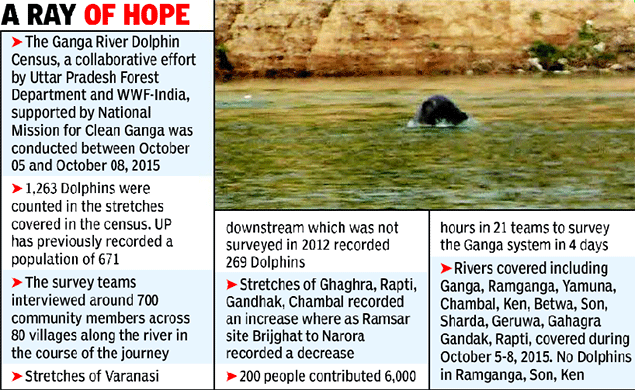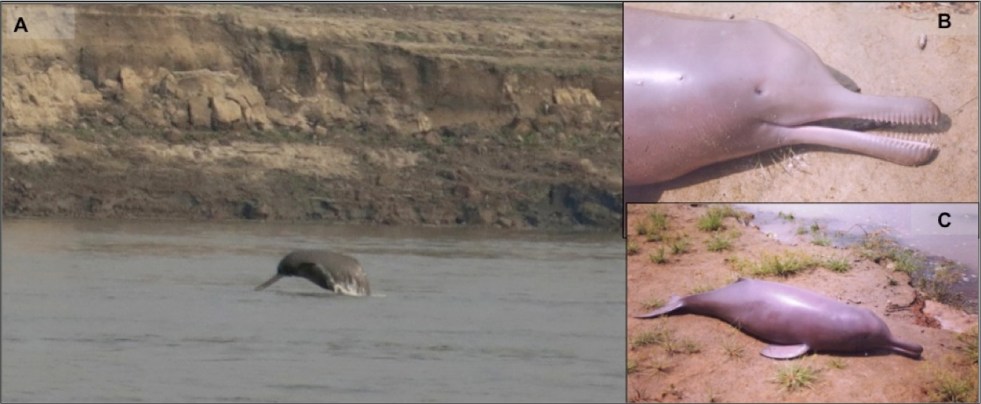Above: (A) An image showing the Gangetic dolphin in its wild habitat (photo credit: Kadambari Deshpande), (B) a dead Gangetic dolphin calf (notice the pinhole like eyes), and (C) the calf is 1 m long, and adults measure to 2.6 m (photo credits for B & C: Sushant Dey).
Guest blog by Nachiket Kelkar
In 2015, The Times of India reported on the Ganges River Dolphin census exercise conducted in Uttar Pradesh, with the picture of a water buffalo to pass off as a dolphin. If you do not believe this, check out the image below[i]. Generally, most news reports on the river dolphin, some even by reputed news outlets (e.g. http://alert-conservation.org/issues-research-highlights/2016/5/30/rivers-of-destruction-the-implications-of-indias-national-waterways-bill-for-biodiversity), show the wrong species of dolphins, mostly marine species jumping acrobatically in aquariums. A forest department officer told us during their preparations for the Wildlife Week that, “if we put a beautiful dolphin’s picture, people will get more attracted to conserving the Gangetic dolphin, which is quite ugly, and the poor thing is also blind – toh achcha nahin lagta hai (it does not look good).” It does not stop here. A senior ecologist expressed concern recently in a public lecture, about the river dolphin becoming blind due to pollution. Against this background it is clear how little we know the Ganges Dolphin (our National Aquatic Animal, mind it) even today.

Hence there is nothing surprising about the Water Resources Minister, Ms. Uma Bharti’s recent statement[ii] that “the Ganges River dolphin has become blind because of pollution in rivers”. Ms. Bharti’s statement that dolphins were blinded by river pollution is mindless of the evolutionary origins of this remarkable animal species, but that is not its real undoing. Checking “if dolphins with eyes lose their eyesight, pollution has still not abated in the Ganga River” is not possible – it is tantamount to erecting and then destroying a straw man. Unfortunately, this silly idea does play on the mind of people, and at an aggregate level, might do well to fool the public that this will be a ‘real test’ of the Ganga clean-up program.
Of course, our poor appreciation of the conservation needs and the ecological world of the endangered Gangetic dolphin is due to multiple reasons. These reasons reside in the widespread general neglect of freshwater biodiversity in our water management policies and paradigms, and in our craze for sensational news bytes. But the root cause lies perhaps in how we as a society continue to treat “differently abled” beings around us. Whether human or non-human, we often wrongly believe that mere show of sympathy or pity is what will change their lives. More often, these lives just need civic assurance that they will be secure, for instance, while crossing a road in heavy traffic hours. But such assurance is rarely even seen. The minister’s statement’s banality is in the fact that it triggers misplaced sympathies instead of sensitized action to reduce the mounting pressures on riverine biodiversity.
If differently abled people cannot be treated with any reassurance by this society, what can one say of our differently abled non-human species? The Ganges River dolphin (Image 2) has been alive since 25 million years (as per a large body of geological, genetic, and paleontological evidence[iii]). The Indus-Ganga-Brahmaputra basins that took birth as the Himalayas formed, carried millions of tonnes of sediment from the young mountains to the plains. This was a geological and tectonic activity whose scale or extent we may find hard to even imagine. If not for the murkiness of these rivers, the fertile alluvial silt that these rivers deposit, supporting over 500 million people’s lives today, would not have existed! The murkiness is not pollution: in fact turbidity is a driver of the productivity of large floodplain rivers[iv].
In the sediment-laden waters, bearing eyes for an animal was evolutionarily too costly – for the biological investment in them was rendered suboptimal by the silt-laden, poor visibility of the river. Sightlessness was a natural evolutionary adaptation to a murky environment, and the Gangetic and Indus dolphins adapted accordingly for life in dynamic floodplain rivers. Evidence from fossils of now-extinct animals, the long lost cousins of these river dolphins, clearly proves the origins of these adaptations through evolution’s tinkering[v]. These dolphin subspecies can distinguish the lit surface of the river from the dark bottom, so they are not completely sightless. The echolocation system of the dolphin has became highly sophisticated as a compensatory mechanism, in evolutionary time, in fact it is so fine-tuned that the dolphin can actually ‘see’ with echoes only in a tight cone in front of its snout, as detailed studies on the species have consistently shown since the 1970s till date[vi]. It can resolve tiny structural differences with series of high-frequency click sounds. High frequencies mean short wavelengths, which translates to being able to detect obstacles very close to its body.
Having said that, if there is something to really worry about, it is about the dolphin’s survival and sustenance of its habitat rather than its natural eyesight. The river dolphin’s habitat continues to get more and more polluted, its space is shrinking because of the widespread wastage and abuse of water, and fragmenting by dams and barrages[vii]. its future will likely be a noise-filled and stressful one, with plans imminent to link India’s rivers and another set of plans to convert them into waterways by construction of ports, barrages and ecologically damaging dredging practices[viii]. Perhaps we should worry more about how the dolphin could breathe easy today, instead of whether it can see or cannot see.
After 70 years of meaningless and superficial pity, India is now gearing up with the Accessible India campaign for disabled-friendly amenities in public places. Is it so difficult to imagine our rivers in a similar way for the security of river dolphins (and in turn for other aquatic species)? The river dolphin does not need our pity. It just needs an assurance that it can swim across the river safely – free from any fear of deathly fishing nets, the deafening noises of dredgers or large ships, and in waters unbound by dams or barrages.
Nachiket Kelkar (rainmaker.nsk@gmail.com)
END NOTES:
[i] http://timesofindia.indiatimes.com/home/environment/flora-fauna/Dolphins-rise-in-Ganga-surprises-environmentalists/articleshow/49536187.cms, 26th October 2015.
For other examples of wrong pictures see:
- http://timesofindia.indiatimes.com/city/kolkata/West-Bengal-may-get-dolphin-reserve/articleshow/49199999.cms
- http://delhigreens.com/2010/05/27/dolphin-declared-as-the-national-aquatic-animal-of-india/
- http://www.daily-sun.com/post/119906/River-Dolphin-
[ii] This statement was made in the Lok Sabha on August 4, 2016 by Union Minister of Water Resources, River Development and Ganga Rejuvenation, Su. Shri Uma Bharti. When someone filed an RTI with Ministry of Water Resources, he got a reply that the Ministry has no scientific evidence to support this (see: http://www.dnaindia.com/india/report-sorry-boss-you-are-wrong-water-ministry-contradicts-uma-bharti-s-claim-that-dolphins-go-blind-due-to-pollution-2250038). When this RTI response was flashed in media on Aug 29, 2016, the Press Information Bureau of Government of India came out with a clarification on Aug 31, 2016 (http://pib.nic.in/newsite/PrintRelease.aspx?relid=149405), which said: “A section of the media has reported that Union Minister for Water Resources, River Development and Ganga Rejuvenation Su. Shri. Uma Bharti might have claimed in Lok Sabha that Gangetic Dolphins got blind because of pollution but her Ministry does not have any scientific basis to buttress the claim. The report also quoted the RTI reply received from the Water Resources Ministry. In this connection it is clarified that different activities related to Ganga are reviewed by the cabinet Minister at regular intervals. During one such review the “aqua life” of Ganga was also reviewed. In this review a presentation was made by an expert on aqua life in which the Minister was informed that dolphins in Ganga are getting blind due to pollution in the river. Therefore, the statement by the Minister is factually correct. The National Mission for Clean Ganga has ordered an inquiry to find out how this factual information was not added while responding to the RTI query.”
It’s noteworthy that the Ministry has not made the name of “an expert on aqua life”. In any case, how can attributing such a statement to an unnamed expert can become “factual information” supporting minister’s statement really begs logic.
[iii] See work by Hamilton, H. C., S. Caballero, A.G. Collins and R. Brownell Jr. 2001. Evolution of river dolphins. Proceedings of the Royal Society of London 268:549-558.
[iv] This has been reported by numerous studies on geomorphology and hydrology of the Himalayan rivers. A key reference on the Ganga is Singh M, Singh IB, Müller G. 2007. Sediment characteristics and transportation dynamics of the Ganga River. Geomorphology, 86(1-2): 144-175.
[v] Cassens, I., S. Vicario, V.G. Waddell, H. Balchowsky, D. van Belle, Wang Ding, Chen Fan, R.S. Lal Mohan, P.C. Simoes-Lopes, R. Bastida, A. Meyer, M. Stanhope, and M. Millinkovitch. 2000. Independent adaptations to river habitats allowed survival of ancient cetacean lineages. Proceedings of the National Academy of Sciences 97: 11343-11347
[vi] See for example: 1) Herald, E. S., R.L. Brownell, F.L. Frye, E.J. Morris, W.E. Evans and A.B. Scott. 1969. Blind River Dolphin: first side-swimming Cetacean. Science, 166: 1408-1410. 2) Pilleri, G. 1974. Side-Swimming, Vision and Sense of Touch in Platanista indi (Cetacea, Platanistidae). Specialia, 30: 100-104. 3) Jensen, F.H., Rocco A, Mansur R.M., Smith B.D., Janik V.M., et al. (2013) PLoS One 8(4): e59284.
[vii] Research from Patna in the 1990s (e.g. Kannan et al. 1997) showed that river dolphins are accumulating heavy metals and pesticides in their skin and blubber tissues. Local extinction of these dolphins from upstream reaches due to barrages has been well documented in the Indus River basin (Braulik et al. 2014). The current debates on the Farakka barrage and its long-term negative impacts on the lower Gangetic basin’s ecology must be heeded to in this context as well.
Kannan, K., K. Senthilkumar, R.K. Sinha. 1997. Sources and accumulation of butyltin compounds in Ganges River dolphin, Platanista gangetica. Applied Organometallic Chemistry, 11: 223-230.
Braulik, G.T., Arshad, M., Noureen, U., Northridge, S. 2014. Habitat fragmentation and species extirpation in freshwater ecosystems: causes of range decline of the Indus River Dolphin (Platanista gangetica minor). PLoS One, 9: e101657.
[viii] See for details: https://sandrp.wordpress.com/2016/02/19/digging-our-rivers-graves/ and https://sandrp.wordpress.com/2015/12/28/four-boats-at-a-river-crossing/

very good post and helpful. thanks for Sharing.
LikeLike